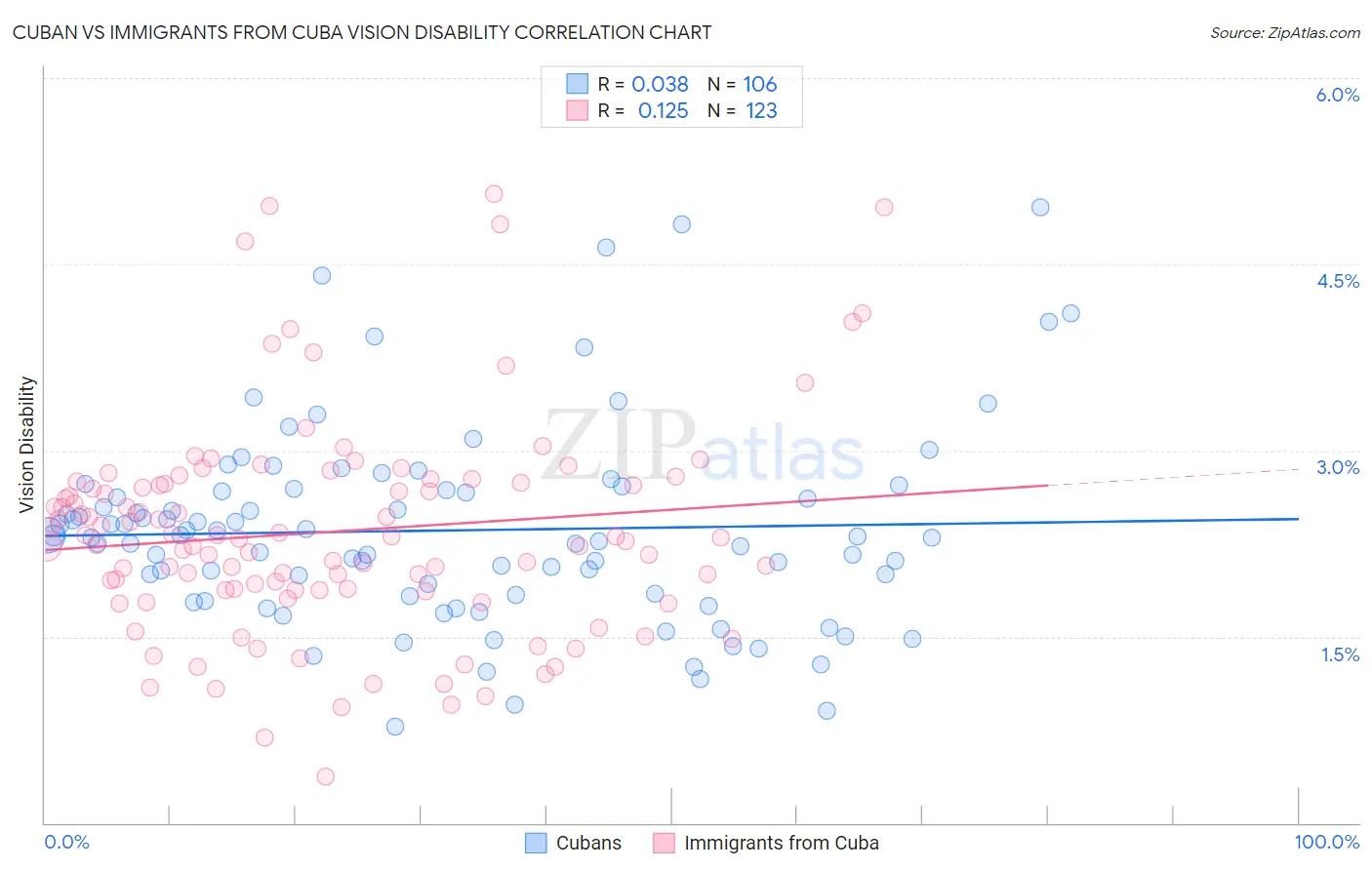Cuban vs Immigrants from Cuba Vision Disability
COMPARE
Cuban
Immigrants from Cuba
Vision Disability
Vision Disability Comparison
Cubans
Immigrants from Cuba
2.4%
VISION DISABILITY
0.1/ 100
METRIC RATING
270th/ 347
METRIC RANK
2.5%
VISION DISABILITY
0.0/ 100
METRIC RATING
290th/ 347
METRIC RANK
Cuban vs Immigrants from Cuba Vision Disability Correlation Chart
The statistical analysis conducted on geographies consisting of 448,885,451 people shows no correlation between the proportion of Cubans and percentage of population with vision disability in the United States with a correlation coefficient (R) of 0.038 and weighted average of 2.4%. Similarly, the statistical analysis conducted on geographies consisting of 325,877,901 people shows a poor positive correlation between the proportion of Immigrants from Cuba and percentage of population with vision disability in the United States with a correlation coefficient (R) of 0.125 and weighted average of 2.5%, a difference of 3.1%.

Vision Disability Correlation Summary
| Measurement | Cuban | Immigrants from Cuba |
| Minimum | 0.77% | 0.38% |
| Maximum | 5.0% | 5.1% |
| Range | 4.2% | 4.7% |
| Mean | 2.4% | 2.3% |
| Median | 2.3% | 2.3% |
| Interquartile 25% (IQ1) | 1.8% | 1.9% |
| Interquartile 75% (IQ3) | 2.7% | 2.7% |
| Interquartile Range (IQR) | 0.85% | 0.87% |
| Standard Deviation (Sample) | 0.80% | 0.87% |
| Standard Deviation (Population) | 0.79% | 0.87% |
Demographics Similar to Cubans and Immigrants from Cuba by Vision Disability
In terms of vision disability, the demographic groups most similar to Cubans are Immigrants from the Azores (2.4%, a difference of 0.16%), Spaniard (2.4%, a difference of 0.26%), Immigrants from Bahamas (2.4%, a difference of 0.59%), Immigrants from Latin America (2.4%, a difference of 0.90%), and Chippewa (2.4%, a difference of 1.2%). Similarly, the demographic groups most similar to Immigrants from Cuba are Nonimmigrants (2.5%, a difference of 0.14%), French American Indian (2.5%, a difference of 0.55%), Honduran (2.5%, a difference of 0.57%), Sioux (2.5%, a difference of 0.71%), and Immigrants from Central America (2.5%, a difference of 0.72%).
| Demographics | Rating | Rank | Vision Disability |
| Cubans | 0.1 /100 | #270 | Tragic 2.4% |
| Immigrants | Azores | 0.1 /100 | #271 | Tragic 2.4% |
| Spaniards | 0.1 /100 | #272 | Tragic 2.4% |
| Immigrants | Bahamas | 0.1 /100 | #273 | Tragic 2.4% |
| Immigrants | Latin America | 0.0 /100 | #274 | Tragic 2.4% |
| Chippewa | 0.0 /100 | #275 | Tragic 2.4% |
| Scotch-Irish | 0.0 /100 | #276 | Tragic 2.4% |
| Bahamians | 0.0 /100 | #277 | Tragic 2.4% |
| Spanish | 0.0 /100 | #278 | Tragic 2.4% |
| Nepalese | 0.0 /100 | #279 | Tragic 2.4% |
| Cape Verdeans | 0.0 /100 | #280 | Tragic 2.4% |
| U.S. Virgin Islanders | 0.0 /100 | #281 | Tragic 2.5% |
| Immigrants | Caribbean | 0.0 /100 | #282 | Tragic 2.5% |
| Puget Sound Salish | 0.0 /100 | #283 | Tragic 2.5% |
| Yakama | 0.0 /100 | #284 | Tragic 2.5% |
| Immigrants | Central America | 0.0 /100 | #285 | Tragic 2.5% |
| Sioux | 0.0 /100 | #286 | Tragic 2.5% |
| Hondurans | 0.0 /100 | #287 | Tragic 2.5% |
| French American Indians | 0.0 /100 | #288 | Tragic 2.5% |
| Immigrants | Nonimmigrants | 0.0 /100 | #289 | Tragic 2.5% |
| Immigrants | Cuba | 0.0 /100 | #290 | Tragic 2.5% |